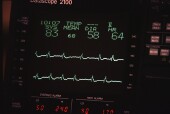
THURSDAY, June 10 (HealthDay News) — A large new study suggests that surviving a hospitalization for heart attack, stroke or pneumonia may depend, at least in part, on the type of insurance you have.
The death risk from these common medical conditions is significantly higher for working-age Americans who are uninsured or on Medicaid than for privately insured patients, researchers have found.
For every 100 heart attack patients, for example, the in-hospital death rate was 2.22 percent for privately insured patients, versus 4.03 percent for the uninsured, the study found.
“The most important thing to consider is that even one excess death among a hundred heart attack patients, which may be related to being uninsured, is one too many,” said lead author Dr. Omar Hasan, a Harvard Medical School instructor and a hospitalist at Brigham & Women’s Hospital in Boston.
The study did not reveal the reasons for such disparities in care, although Hasan suspects a combination of factors, such as provider sensitivity to insurance status and uninsured patients’ limited access to primary care. He also cited studies showing that people who are uninsured are less likely to undergo high-cost medical procedures, such as heart bypass surgery.
American Heart Association president Dr. Clyde Yancy urged caution in interpreting the findings, noting that access to care and quality of care are not the same thing.
“We have to understand that what constitutes very good care, high quality care, begins with access, but it doesn’t end there,” said Yancy, who is also medical director of the Baylor Heart and Vascular Institute at Baylor University Medical Center in Dallas.
Outcomes are driven by multiple factors, such as the practitioner, institution and patient mix, he explained.
Numerous studies have focused on insurance-related disparities in outpatient settings, but very few examine gaps in the quality of inpatient hospital care, the authors noted in their paper, published in the Journal of Hospital Medicine.
Hasan and colleagues analyzed data from more than 150,000 hospital discharges involving adults ages 18 to 64. The cases were culled from over 1,000 hospitals across 37 states in 2005.
Compared with privately insurance patients, hospital deaths from heart attack and stroke were significantly higher for uninsured and Medicaid patients. Based on the death rates in the study, Hasan estimated that uninsured heart attack and stroke patients faced a 50 percent and 44 percent higher risk of dying, respectively, than the privately insured.
The in-hospital death rate for Medicaid patients with pneumonia was also significantly higher (a 21 percent rise) than for people with insurance, the study found.
The higher death rates remained even after researchers adjusted for various patient characteristics, including severity of illness.
Medicaid recipients had longer lengths of stay for all three conditions, while hospital costs were higher for Medicaid recipients hospitalized for stroke and pneumonia.
Hasan believes that the passage of health reform legislation earlier this year creates new opportunities to improve the quality of health-care delivery, however.
“Policymakers and administrators should take steps to ensure that equity in health-care delivery is appropriately measured and [that] reducing insurance-related gaps in quality remains the focus of quality improvement efforts,” he said.
Yancy cited the American Heart Association’s own hospital-based quality improvement program, called “Get With The Guidelines,” as an example of the type of initiative in addition to expanding access to care that is needed to maximize outcomes.
More information
There’s more on finding good hospital care at the Hospital Quality Alliance.

